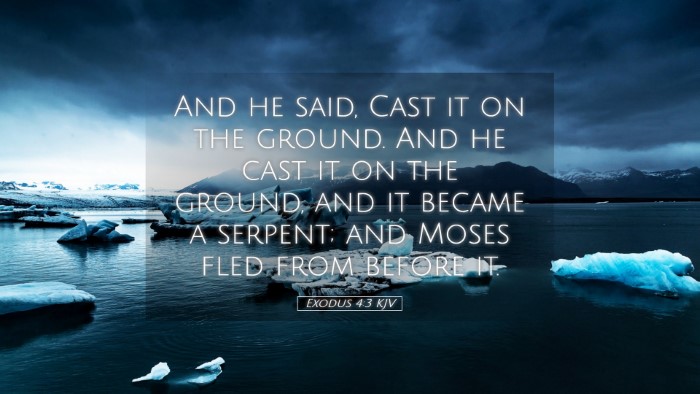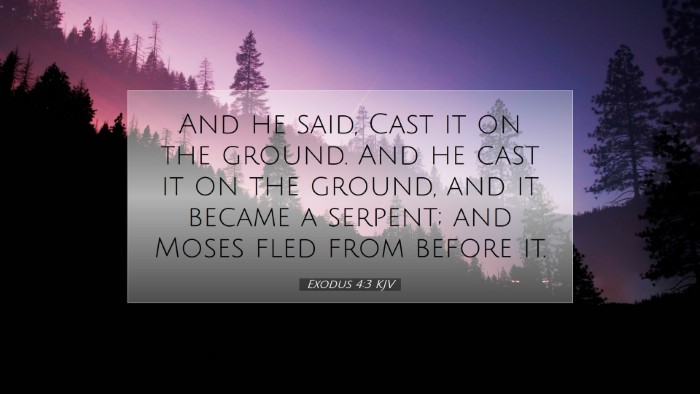Commentary on Exodus 4:3
Verse Reference: Exodus 4:3
“And he said, Throw it on the ground. So he threw it on the ground, and it became a serpent; and Moses fled from it.”
Introduction
This pivotal moment in Exodus captures a profound interaction between God and Moses, focusing on the symbolism and the spiritual significance of the transformation of Moses’s rod into a serpent. Commentators throughout history, including Matthew Henry, Albert Barnes, and Adam Clarke, provide unique insights into this passage, offering implications for faith, divine authority, and the nature of signs.
The Significance of the Rod
Matthew Henry's Perspective: Henry notes that the rod symbolizes the authority and power of God. To throw the rod down signifies surrendering one’s own strength and acknowledging God’s sovereignty. This act illustrates how ordinary objects can become instruments of divine purpose when placed in God's hands.
Albert Barnes adds: The rod represents Moses’ personal capabilities and his calling. By casting down what he relied upon, it serves as a metaphor for believers relinquishing their trust in human means and embracing divine intervention. Barnes emphasizes that God uses the familiar to reveal the extraordinary.
Adam Clarke comments on the transformational aspect: The metamorphosis of the rod into a serpent highlights the theme of change and the potential for divinely empowered transformation. Clarke argues that this symbolizes fear and the unknown; the serpent, often seen as a threat, represents the challenges that Moses will face in his mission.
The Symbolism of the Serpent
The transformation from rod to serpent is laden with meaning. The serpent often connotes danger but is also a symbol of wisdom and divine mystery.
- Henry observes: The serpent reflects the enemies of God’s people—those whom Moses must confront. The sign serves as a reminder that the power of God can overcome evil.
- Barnes interprets this symbol: As the serpent gains life from an inanimate object, it illustrates how the Lord can take frail and human instruments and empower them to achieve His purposes, signifying both the potential for destruction and the opportunity for deliverance.
- Clarke highlights: The fear Moses displays upon witnessing the serpent signifies the natural human response to divine challenges and the necessity for faith to confront these fears.
Moses’ Response and Fear
Moses’ immediate reaction—fleeing from the serpent—reveals a common human instinct when faced with the supernatural. This fear can serve as a barrier to fulfilling God’s calling.
- Matthew Henry explains: God’s signs can initially evoke fear; however, this fear is often a precursor to spiritual growth and understanding. Moses' flight symbolizes the struggle many face in reconciling fear with faith.
- Barnes elaborates: Fear is part of the journey; God encourages Moses despite his weaknesses. This moment teaches that recognizing one’s limitations is the first step toward divine empowerment.
- Clarke emphasizes: The reality of fear should not deter leadership. Instead, it should be seen as an opportunity for faith development, demonstrating that God provides reassurance and strength in moments of anxiety.
Divine Assurance and Commissioning
Following this encounter, God reaffirms His presence and power in Moses’ life, reinforcing the theme of divine assurance in ministry.
- Henry notes: Following the sign, God’s assurance serves to embolden Moses, reminding him that the power behind him is greater than the fear ahead of him.
- Barnes points out: The signs are not just for Moses’s assurance; they are intended to demonstrate God’s authority to the Israelites, showcasing a God who engages actively in their liberation.
- Clarke insists: The miracle acts as a precursor to the greater wonders to come. God prepares Moses to perform miracles not just for his benefit but as a way to instill faith in others.
Theological Reflections
This passage invites deeper reflection on the nature of God’s call and the human response to it:
Faith and Obedience
The act of throwing the rod down reflects the theme of obedience. Believers are often called to act in faith first before the understanding and evidence of God’s work becomes clear. This passage teaches the importance of obedience amidst fear and uncertainty.
God’s Sovereignty
The transformation of the rod into a serpent illustrates God’s ultimate authority over creation. It reminds the reader that God can transform the ordinary into the extraordinary, and what appears to be threatening can also be used for His glory.
Strength in Weakness
Moses’ fear emphasizes a profound truth in Christian thought: God uses weak vessels to accomplish His purposes. The reliance on one’s strength must be shifted to God’s enabling strength, a theme prevalent across Scripture.
Conclusion
Exodus 4:3 serves as a powerful reminder of God’s engagement with humanity. Through the symbols of the rod and serpent, and Moses’ fearful flight, we see themes of faith, divine authority, and God’s transformative power. Pastors, students, theologians, and Bible scholars alike can draw on these insights to understand the broader narrative of God’s redemptive work and His call on our lives to act in faith amidst fear.


